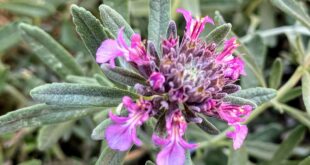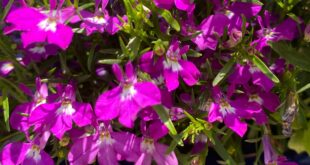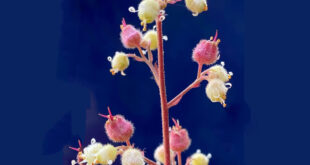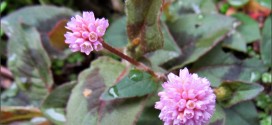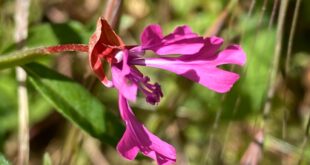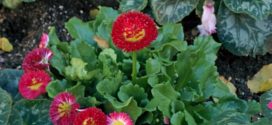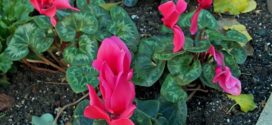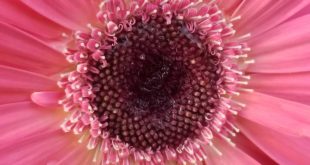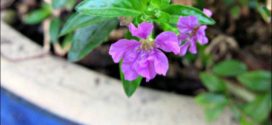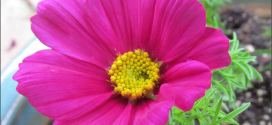This charming, fragrant groundcover hails from Greece. Masses of 3/4” two-lipped mauve flowers appear in late Spring and continue well into Fall! The bee-attracting flowers exude a honey scent while the oblong silvery-green leaves offer a pleasing woodsy fragrance. Like most Teucriums, this “Gray Creeping Germander” is a tough little guy, managing very well with little water and poor soil, …
Read More »Tag Archives: pink
Lobelia erinus “Fountain Rose”
Lobelia erinus “Fountain Blue”xThis variety of Lobelia has masses of graceful, tumbling pink half-inch flowers. It softens the edge of the garden container as well as hanging baskets and window boxes. Blooms forever it seems and often lives over here in USDA Zone 8b, and always self-sows to grace your gardening world every year. Use rich soil for prettiest show! …
Read More »Island Alum Root
Island Alum Root (Heuchera maxima) is a species of flowering plant in the saxifrage family. It is endemic to three of the eight Channel Islands of California, where it grows on cliffs. It is rare in the wild due to its limited distribution. However, it is also cultivated as an attractive garden plant, valued for both its foliage and flowers. …
Read More »Pink Knotweed
Pinkhead knotweed plants (Polygonum capitatum orPersicaria capitata) are considered excellent low-growing groundcover by some gardeners. They are also called invasive pests by others. If you read up on pink knotweed information, you’ll find that the plant is banned in England and considered invasive in California. This is because of its tendency to spread where it wasn’t invited. In our Sunnyvale garden …
Read More »Clarkia concinna – Red Ribbons
Clarkia concinna is a species of wildflower in the Onagraceae (Evening Primrose) family known as Red Ribbons. It is endemic to California, where it can be found in the northern Coast Ranges from Santa Clara County to Humboldt County, and in the Sierra foothills. This is an annual plant with erect, herbaceous stems. The distinctive flowers have four looping sepals of …
Read More »English Daisy – Bellis perennis
English Daisies have long been popular for spring bedding, particularly in mild winter regions. Plants are biennial, usually lasting through one season, but self-seeding to provide future generations. This strain flowers well even in the first year, with little double button flowers of bright rose pink. Removing faded flowers regularly will keep plants blooming well into the summer. Often used …
Read More »Cyclamen – Latinia Salmon
Cyclamen is a great winter-flowering plant that loves light shade. You can grow in indoors or out. I am currently using them as a winter highlight in my former firepit. The red cyclamen is classic for the winter holidays. This salmon variety is also pretty. Strong stems bear vibrant, filly flowers well above attractive, silver-mottled leaves. In the summer, the …
Read More »Gerbera Daisy
New to our Sunnyvale garden in 2020 are Gerbera daisy flowers. The blooms are large (4 inches across) and have a central disk that can be yellowish, light-bronze, or dark in color. This disk is surrounded by rays that come in a variety of colors. The colors are most commonly yellow, red, or orange. However, growers have also produced varieties …
Read More »Mexican Heather
Cuphea hyssopifolia, commonly called Mexican heather, is native from Mexico to Guatemala. It is a rounded, densely branched 1-2’ tall tropical sub-shrub. It produces quaint, small, trumpet-shaped flowers with six spreading lavender petals and green calyx tubes. Flowers appear singly in the leaf axils along stems crowded with lance-shaped glossy green leaves (to 3/4” long). Blooms profusely summer to frost. …
Read More »Cosmos
Common Cosmos, Mexican Aster. Cosmos are annuals, grown for their showy flowers. The flowerheads may be bowl– or open cup–shaped and are atop of long stems. Cosmos are easy to grow and make good border or container plants. They make for good decorations in flower arrangements and also attract birds, bees, and butterflies to your garden. Family: Asteraceae (ass-ter-AY-see-ee) (Info) …
Read More »